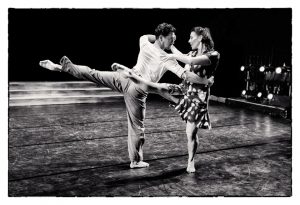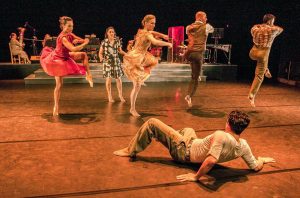Dances with Choirs: Malashock at the Forum, Morris at the Barclay
Mark Morris formed his dance group in 1980, when John Malashock was still dancing with Twyla Tharp. Fast forward 35 years and we discover the two men presenting dances with choirs over the same May weekend in Southern California — Malashock at the Forum at UC San Diego, and Morris at the Barclay at UC Irvine. Their aesthetic is remarkably similar and divergent. If you wished they could sit in on each others’ rehearsals, get in line.
Mark Morris’ danced opera Dido and Aeneas is a masterful retelling of Virgil’s epic poem, “Aeneid.” It uses Henry Purcell’s 1689 composition, the first truly great opera composed by an Englishman. Surprisingly, it was composed for a girls’ school. The dancing master there had fancy friends, including England’s poet laureate, Nahum Tate, who wrote the libretto.

Mark Morris Dance Group in “Dido and Aeneas.” Program Image: Susana Millman
For years after its premiere in 1989, Morris danced the good and evil roles of Queen Dido and Sorceress. On Friday, we could see the top of his head as he conducted the Musica Angelica Baroque Orchestra from the pit. He’s known for his commitment to live music and regularly collaborates with top musicians. The Bob Cole Conservatory Chamber Choir from Cal State Long Beach and five soloists were outstanding. Still, we strained to hear the achingly rich lyrics, such as Dido’s beautifully tragic aria “When I am Laid in Earth.” The program included an insert with Tate’s libretto, a kind gesture, but a couple seated near me wondered what language they were singing. It was English. Nothing was lost in translation when it came to dancing the ancient tale.
Queen Dido of Carthage falls in love with the Trojan hero Aeneas who washes up on the shores of Carthage after the fall of Troy. Morris conjures mythical characters with understated poses and exotic movements reminiscent of murals and sculptures. Dancers pounding their feet sounded like a thunderstorm and foreshadowed impending doom.
Twelve dancers from the Mark Morris Dance Group alternated in multiple roles. The tall and lean Laurel Lynch danced both Dido and the Sorceress morphing from smooth to rugged lines and switching her hair. Domingo Estrada projected the irresistible charm of a hot movie-star. He gave the crowd a naughty wink before strutting off with Dido for a romp. The Trojan sailor scene was delightfully sung and danced with lively Irish jigs and hints of a baseball game. Then came the Sorceress and her hilarious witches and their favorite couplet: “Our plot has took, the Queen’s forsook.”
Sets by Robert Bordo gave the stripped down production a royal setting with very little. A watery blue map of the ancient world and knee-high columns were visually attractive and useful. The role of Belinda, Dido’s lady in waiting-sister, was especially intriguing as danced by Michelle Yard, and the most enunciated as sung by soprano Sherezade Panthaki.
The secondary roles in Malashock’s Snakeskin were also enchanting. Caryn Glass as the reckless troublemaker Carol made bullying and gossiping a deadly sport. Physically wild-cat dangerous, she could star in one of those hateful and violent daytime TV shows. Her suitor Duke, danced by Justin Viernes, would fit right in too.

Justin Flores and Lara Segura portray Val and Lady in “Snakeskin.” Image: Raymond Elstad
Like Dido, Malashock’s Snakeskin is a dance with choir, but not exactly a danced opera, or contemporary ballet. Malashock calls it a dance drama. Krishan Oberoi wrote the music and lyrics, and directed his Sacra/Profana from the stage. His eclectic score fuses a deep range of musical genres with echoes from Stravinsky to Americana. My Sandiegostory.com colleague Ken Herman dives into that critical discussion.
Snakeskin is a retelling of the Tennessee William’s play, Orpheus Descending, a sad depiction of a Southern town and its nosy inhabitants. Everything explodes when a happy drifter wanders in and rocks their bigoted and chauvinist world.
Malashock cast the intensely handsome Justin Flores to dance the role of Val, the drifter. His bare-chested charm lures Lady the shopkeeper away from her abusive husband Jabe. Lara Segura’s Lady is timid and hunched over until she is alone with Val. In a loving duet, Flores lifts her far above his head, the equivalent of delivering her from deep despair to ultimate pleasure. They sneak away and roll in the shadows, but are discovered and shunned, and things don’t end well at all.
Malashock likes to play with combative choreography. Here, the abusive and attacking sequences were filled with somersaults and thrilling flips. Jabbing phrases in circles had the deadly tone of Pina Bausch’s Rite of Spring. The physical appearance of Nicholas Strasburg’s Jabe, bulky and bald-headed, intensified our fear of domestic violence. He and his crony Duke, danced by the limber Justin Viernes, exuded good ‘ol boy dimness in suspenders, as when they fought each other for kicks, and dragged their wives with pride.

Blythe Barton (center), Caryn Glass (left) and cast in “Snakeskin.” Image: Raymond Elstad
Malashock made the Southern ladies look prim, but under their vintage summer dresses, they were scrappy meddlers. Lady was the town’s favorite kick around, forced to wear a blotchy print and apron. Her repeating hand to lips gesture suggested secret words between her and drifter. Weaker scenes had her wander with little to do but stare at the sky, and it seemed those dances were unfinished. Lyrics about soil and an orchard didn’t help. She seemed ready to break into song, but this was not a musical.
The secondary roles were more inspired and abstract. Blythe Barton was excellent as Vee the town’s busybody in a tightly braided bun, inciting group attacks and whispers with nuance and believable expression. Brittany Taylor and Heather Glabe as Dottie and Beulah had to race to keep up with her long strides on the diagonals.
Malashock and Oberoi were intent on setting the production in the South, but Barton and Glass created characters that broke away from that static mold with visceral presence. Through pulsing movement and focus, they predicted the tragic finale and projected regret and shame, and they didn’t need music or lyrics to drive that home.

Kris Eitland covers dance and theater for Sandiegostory.com and freelances for other publications, including the Union Tribune and Dance Teacher Magazine. She grew up performing many dance styles and continued intensive modern dance and choreography at the Univ. of Minnesota, Duluth, and San Diego State Univ. She also holds a journalism degree from SDSU. Her career includes stints in commercial and public radio news production.
Eitland has won numerous Excellence in Journalism awards for criticism and reporting from the San Diego Press Club. She has served on the Press Club board since 2011 and is a past president. She is a co-founder of Sandiegostory.com. She has a passion for the arts, throwing parties with dancing and singing, and cruising the Pacific in her family’s vintage trawler. She trains dogs, skis, and loves seasonal trips to her home state of Minnesota.
